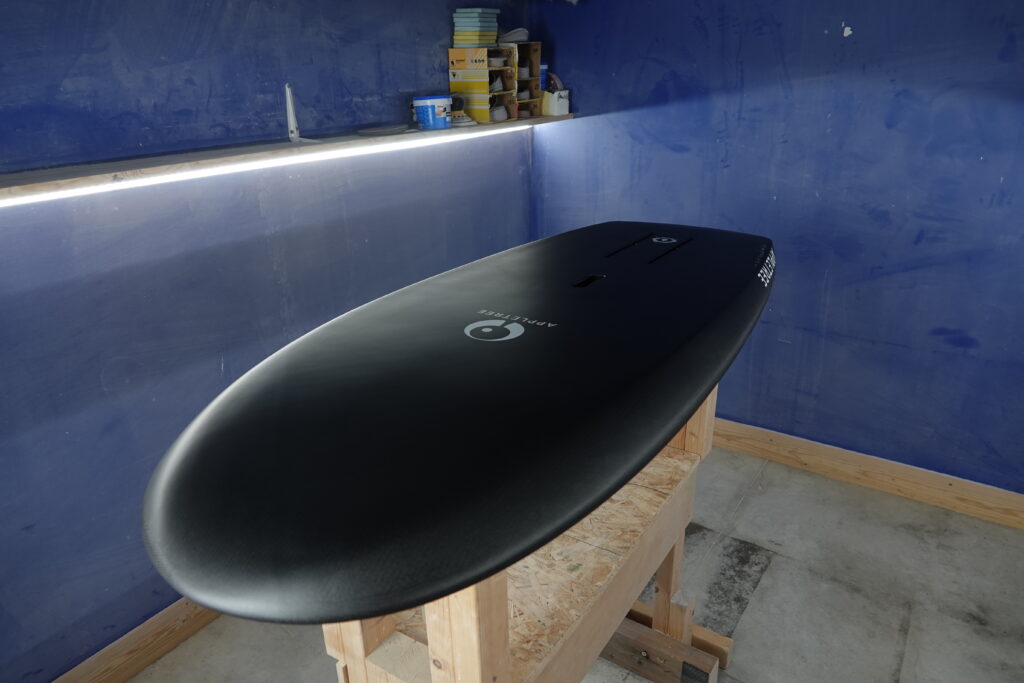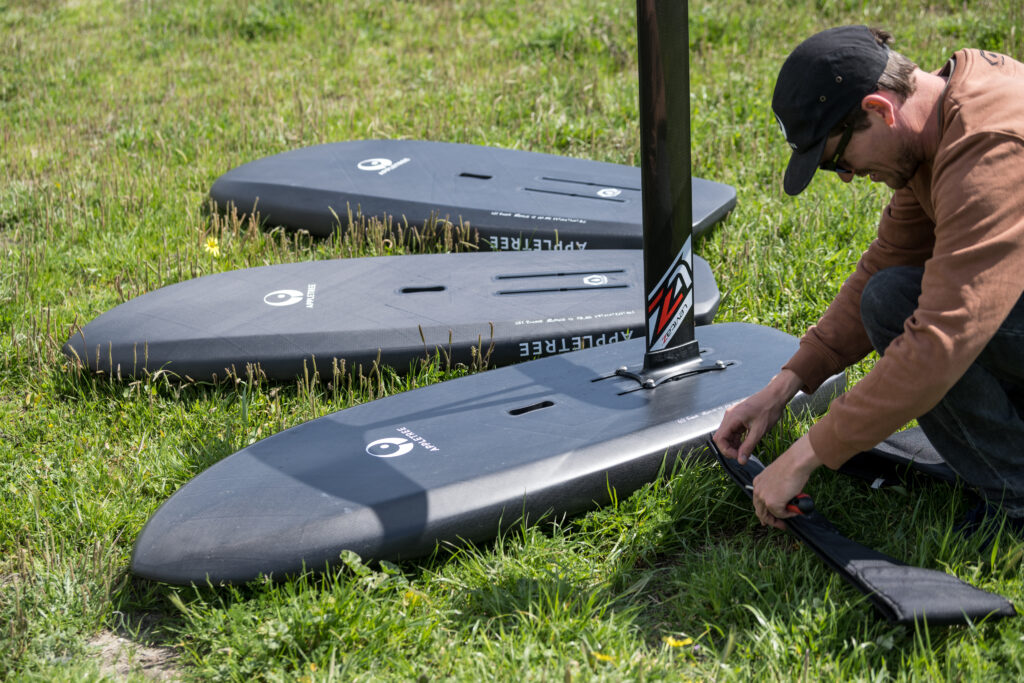Tech talk: Jazz vs Slice
29.08.2022
Hello, everyone. Welcome back to Appletree Surfboards HQ. My name is Wieger, I’m co-founder of Appletree Surfboards and today we’re going to talk about the differences between the Slice V2 and the Jazz. Two different types of wing boards that we have.
We get asked this question all the time, because right now we have two different types of wing boards in our lineup. So what are the key differences between those two? Well, I’ve got two here in roughly the same size. They’re both around 60 liters, in case of this Jazz it’s 62.5 liters and the Slice V2 that I have here is a 60 liter. It’s really nice to have both in a similar size, so you can see the differences up close.
Why 2 different types of wing boards in the Appletree lineup?
Before Appletree Surfboards only had one wing board in the range, which was the Slice V1. This board worked really well for a long time, but winging as a sport has developed super quickly. It’s developing in a lot of different directions and we felt the need to split up the range in boards for the specific needs of specific riders.
How is the Jazz different than the Slice?
We have made the Slice V2 and the Jazz, 2 different types of wing boards. Now, first of all, the Jazz is the board I’ve got here. It’s more of a freestyle oriented board, but it’s not a pure freestyle board. That’s an important one. The main differences that it is shorter and it is a bit wider and the bottom contour is also a bit wider. So it is a wider platform. This works really well when you are trying to land your tricks because it sort of naturally bounces back up. But at the same time, a wider bottom and a flatter bottom also gives you a more effective planing. So it gets you up to speed quicker and consequently up to foil quicker. This is a really important one in the bigger sizes. So like the 90 liter and the 75 liter Jazz, these are really nice light wind boards as well. They double really nicely in that.
How to choose the right board size
In the smaller sizes, they are more for advanced riders, but still the boards are really easy to ride. So for instance, for myself personally, I tend to ride this 62.5 liter 4’8″ that I’ve got here as my go-to board for when the winds are sort of over 16 knots. I can easily still ride this board. It comes up to the surface super quickly because for me, this is a sinking board, and then it’s up onto the foil really quickly.
Design features of the Jazz
Now a couple of design features in this board. As you can see, it got this really nice flat bottom with a straight tail running behind the foil boxes. The boxes are placed a little bit further back then on the other board, which we’ll see later, mainly because most of the freestyle riders tend to ride their foil a little bit further back because it’s easier to keep under control when you’re a bit more forward on your foil.
You see it’s really soft and it’s pretty wide running in through a harder bevel on the edge, but the bevels really far to the site effectively making the bottom of the board wider. So you get that really nice wide platform, nice handle in the bottom. You see from the side, it’s a really rounded shape and as you can also clearly see in this view is that the wide point is quite far forward. This really helps when you are coming down a landing because it has most of the width under your front foot. So it naturally bounces you back off on the deck.

Why a recess deck?
We have got this nice recess in here. Now the recess is important in our wing boards because what it does, it keeps the standing area where your feet are placed absolutely at 90 degrees or parallel to the foil boxes. At the same time, because this area here on the front is recessed. We could slightly lift the rocker of the rest of the board. So you have to see it as like the rest of the board’s been lifted around this recess. This gets the rocker slightly up. When you touch down again, it wants to push you back up.
Does the board have insert positions for straps?
Yes, the board comes with all the insert positions that you want. Single in the back and then in the front you’ve got the option of having a Y, having a straight line, having sort of a cross from one foot. Whatever you prefer, you can accommodate on the jazz.
Board features of the Slice
Here we have the Slice, it’s a 60 liter, which means a 4’9″. Now this 4’9″ is 23 inches wide where the four eight Jazz that we looked at earlier is 24 inches. It’s a whole inch longer and an inch narrower to get to the same kind of volume. It’s a very different idea of a board. As you can see here, the bevel is much more pulled in. So the board has got more of a slightly boat hull shape and it features the same bottom, that has this straight outline. The foil boxes are slightly more forward. Most of the guys that ride this board want to do a bit more racing and a bit more wave riding where you don’t need all that width. It’s nicer to have a narrower board, as you can actually see the wave and you have less risk of the rail hitting the wave. If the rail does hit the wave, it tends to hit this bevel first. So it bounces back up where the Jazz is more rounded and the bevels more pulled out to the side. This one is way more pulled in.

Are the Jazz and the Slice comparable size for size?
The downside of course, is that if you have a narrower platform it’s slightly less efficient. For example the same conditions that I ride the 62.5 liter Jazz in, I tend to ride a 70 liter Slice to get the same kind of feel. So they are not one on one comparable size for size. That’s a key difference and important to understand if your ride different types of wing boards. Furthermore, if we look at the board, you can see the nose is pretty much pulled in as well. It doesn’t have that rounded nose. It’s got a bit of a displacement hole in the front, and then it’s got the similar kind of recess deck as the jazz has, it’s just a little less pronounced. This has the same purpose, where it sort of levels out your standing area towards the foil on a 90 degree angle and at the same time we can lift that rocker a little bit. Also this board has a straight off tail.
Wing foiling with straps
The insert positions are the same. We’ve got all the same options. The only difference is, the Slice also has an offset position on the tail. So you can have one straight or one insert slightly offset. This does help if you like me always ride in the same position. I’m a regular rider, so my left foot is forward. I will have a cross strap in the front and then in the back, I have it slightly off centered. The reason for this is that I can actually have my back foot really over the middle of the foil. Because if you are only on the middle, your back foot is usually slightly off center, which makes it harder to initiate turns when wave riding. That’s why these inserts come on this board as a standard feature.
Hopefully that shows you a bit of the differences between the different types of wing boards, the Slice V2 and the Jazz. If you have got any questions, always feel free to call us or email us. Leave a comment if you like this video and what you want to see more and hope to see you in the next tech talk video.
Next episode
Excited about our next Tech-Talk video? Or are you wondering if your question will be discussed in the next episode? Sign up for our newsletter and we’ll send you an email when the next video is out!